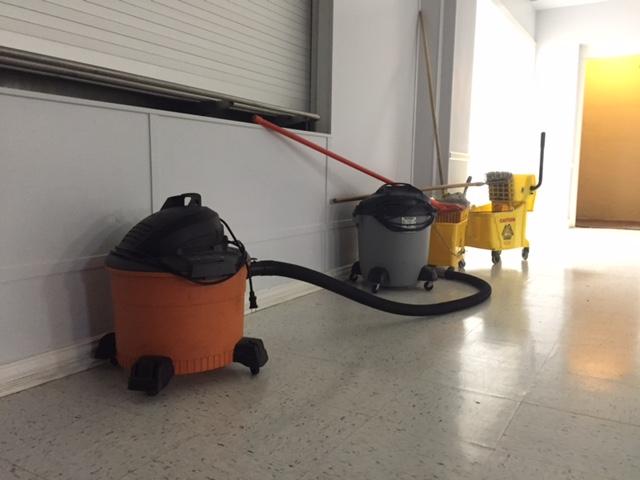This story originally appeared on KERA News.
The first thing mold attacks is often the nostrils.
That musty mildew smell hits you fast in the basement of Marsalis Avenue Church of Christ in Oak Cliff.
Senior Minister Lamont Ross points out the stains on the grey carpet where water seeped in, 15 to 20 feet from the walls. There’s also the water marks and bubbling paint on the walls white paint.
“We’ve had to relocate some of our services,” Ross says. “We had planned on having a father-son breakfast here, but we won’t be able to have that here because of the damage that occurred.”
Fans are whirling and there are several dry vacuum machines next to mops. After the flooding, Ross noticed black dots that looked like ink spots on the wall.
It was mold.
“We’re concerned about the health of our members,” Ross says. “The health of our church staff, we want to make sure we got the mold and mildew.”
Mold In The Headlines — And The Bible
In recent years, mold has crept into headlines. Maybe you’ve heard of black mold or toxic mold – molds that are said to kill.
It turns out fear of mold goes way back. All the way back to the Bible.
In the Old Testament, there were strong warnings about mildew and mold.
Here are a few excerpts from Leviticus 14:
The Lord said to Moses and Aaron: “When you enter the land of Canaan, which I am giving you as your possession, and I put a spreading mold in a house in that land, the owner of the house must go and tell the priest, ‘I have seen something that looks like a defiling mold in my house.’
The priest is to order the house to be emptied before he goes in to examine the mold, so that nothing in the house will be pronounced unclean. After this the priest is to go in and inspect the house. He is to examine the mold on the walls, and if it has greenish or reddish depressions that appear to be deeper than the surface of the wall, the priest shall go out the doorway of the house and close it up for seven days.
On the seventh day the priest shall return to inspect the house. If the mold has spread on the walls, he is to order that the contaminated stones be torn out and thrown into an unclean place outside the town. He must have all the inside walls of the house scraped and the material that is scraped off dumped into an unclean place outside the town. Then they are to take other stones to replace these and take new clay and plaster the house.
If the defiling mold reappears in the house after the stones have been torn out and the house scraped and plastered, the priest is to go and examine it and, if the mold has spread in the house, it is a persistent defiling mold; the house is unclean. It must be torn down—its stones, timbers and all the plaster—and taken out of the town to an unclean place.
Dr. Mark Millard says most people don’t need to be afraid of mold.
“The fact is, mold is everywhere,” says Millard, the medical director of the Baylor Martha Foster Lung Care Center in Dallas. “And we consume a large amount of it. … Our immune systems have been designed to handle it, so for most people, mold isn’t a problem.”
One exception, Millard says, is if you have allergies to mold. Then, exposure to the fungus – really to the tiny spores that are in the air – can cause wheezing, sneezing and coughing.
And for some people with weakened immune systems, there can be a more serious, but rare reaction.
“It’s like a pneumonia that doesn’t get better with antibiotics,” Millard says. “The person is treated with Cortisone, the [other] treatment is to get rid of the mold.”
Mold Cleanup
If mold is growing in your house, you need to clean up the mold and fix the moisture problem.
Mark Hanna, a representative for the Insurance Council of Texas, says homeowners across Texas should tackle mold by taking out wet furniture and carpet, putting in de-humidifiers, and using soap and water.
His advice: Document and file insurance claims.
“We tell people, this is the most valuable thing they own,” Hanna says. “Call your insurance agent, say ‘hey, I want to report a claim get an insurance adjuster out here as quickly as possible.’”
Back at the Church in Oak Cliff, Minister Lamont Ross has already had an adjuster out to see the basement. Mold as a result of flooding or water damage isn’t always covered by insurance, so he’s hoping for the best.
In the meantime, Ross says he won’t exactly be following the advice from The Old Testament.
“No, we don’t plan on tearing down the house,” he laughs. “But we still plan to make sure it’s taken care of.”
Perhaps using a combination of ancient and modern ingredients… water, and bleach.
From the CDC: Cleanup Tips
You can control, and cleanup mold inside your home. The Centers for Disease Control and Prevention offers these tips on its website:
- Inside your home you can control mold growth by: controlling humidity levels; promptly fixing leaky roofs, windows, and pipes; thoroughly cleaning and drying after flooding; ventilating shower, laundry, and cooking areas.
- Mold growth can be removed from hard surfaces with commercial products, soap and water, or a bleach solution of no more than 1 cup of bleach in 1 gallon of water.
- Mold growth, which often looks like spots, can be many different colors, and can smell musty. If you can see or smell mold, a health risk may be present. You do not need to know the type of mold growing in your home, and CDC does not recommend or perform routine sampling for molds. No matter what type of mold is present, you should remove it.
There are special precautions you should take if you’re using bleach to clean up mold — learn more here from the CDC.















